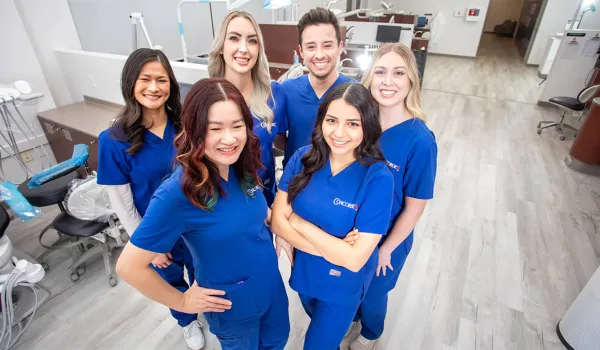
The world of technology is ever-evolving, and many fields have been completely transformed from what they once were by technological breakthroughs and advancements. The medical field is no exception, as many health care advancements have been made thanks to emerging technology. Let's take a look at some of the most prominent ways technology has advanced health care.
Improved Patient Care
Many technological advances have been advantages to ease and efficiency of patient care, as well as patient comfort. For example, radio-frequency identification (RFID) technology (1) can now provide accurate insight on patient vitals and temperature.
In addition, 3D printing has made a vast impact on emerging health care technology. Patients now have access to prosthetics, implants, hearing aids, dental devices, and more that can be quickly and cost-effectively 3D printed. These types of accommodations used to be expensive and difficult to make.
Another example of heightened care is due to the development of virtual reality technology, which can help aid patients in health and fitness as well as depression and anxiety. But it doesn't stop there - augmented reality can also greatly enhance accuracy and precision in difficult or complex operations, especially when paired with other technology like robotic surgery options.
Even beyond surgery, immediate implications regarding typical visits to a physician's office are encouraging. For example, medical assistants are able to utilize handheld computer technology to not only immediately import crucial patient data in real-time, but are able to cross-check and verify important medical information when prescribing medications and recording patient complaints.
Digitalization of Health Care Records
A big perk of health care advancements in technology is the ability to store and transmit health care records easily and efficiently. Gone are the days of bulky paper files that have to be faxed to other medical providers. This shift to digital records not only streamlines the documentation process itself, but reduces costs and improves patient-doctor relationships, as patients get easy access to their health records via an online interface.
Electronic Health Records (EHRs) typically consist of individual patients' medical histories, including lab reports, blood work, medical diagnoses, surgeries, and prescription medication history.
Not only do EHRs foster quick and professional collaboration between labs and health care providers, they reduce time and transportation costs. In addition, they can essentially save a patient's life. For example, if a patient is not conscious and medical decisions have to be made without further information, these records can reveal patient allergies and current medications that may cause interactions with treatment options. In this sense, EHRs can actually help reduce medical malpractice by greatly reducing the possibility for mistakes.
The Development of Mobile App Technology
One of the most helpful technological advances for the convenience and accessibility to patients is the development of health care mobile apps. Now, patients are able to quickly and easily access their medical information on their mobile devices, as well as get personalized care such as direct messaging with their health care provider, appointment reminders, and medication reminders. There are also personalized applications available to help patients improve anxiety and stress, monitor sleep, get therapy without having to go to a physical location, monitor and track their diet and exercise, and more.
Big Data and Cloud Storage
The buzzword "big data" often emerges in many industries, and health care is no exception. However, the potential benefits of big data in health care are exponential. Why? The collection of an extremely large pool of information related to health and medicine can further the accuracy of analytical research, predict health trends and major epidemics, and ultimately speed up the search for disease prevention and eradication.
Information Technology
Not only does the world of information technology (IT) streamline communications in the health care field, but is actively changing the way health care providers interact with their patients. In addition, by comparing data between current patients and other patients, medical professionals are able to get in-depth insight into correlation, risk factors, and options for preventative treatment.
Another positive for the growth of IT in the medical field is the introduction of what is often knows as "medical tourism." This is essentially the ability for patients to establish communication with specialists all over the world. This is especially helpful for patients who are looking for second opinions or consultations with professionals that have a very specific specialty or knowledge that would not have been previously available to them. This also opens up the possibility of scheduling highly advanced surgeries in different states or countries and only having to book travel once.
Virtual Medicine
TeleHealth, sometimes referred to as telemedicine, is essentially a system of virtual health care allowing patients to get medical advice and treatment options from the comfort and safety of their own homes.
Typically, virtual medicine platforms offer a method of sending and receiving images instantly to prevent having to wait to schedule an appointment or go into an office. This way, the medical provider can assess the situation and provide treatment options over the phone if appropriate, or recommend going in to see a provider in person if necessary. Another advantage to virtual medicine is the improved management and increased availability of primary care physicians to monitor chronic conditions of their patients.
Improved Communication Between Medical Providers
The Health Insurance Portability and Accountability Act (HIPAA) creates certain restrictions on communications unless certain confidentiality and procedural systems are in place. However, technological advances have streamlined the ability to have secure, HIPAA-compliant communications between doctors. Some recent technology even allows for instant and secure translation of a doctor's spoken words into a different language.
Portal Technology
An important convenience being adopted by practices all over the world for patients is portal technology. This is the ability for patients to log onto an online interface, or "portal," to get immediate access to not only their personal information that is in the health care system, but their lab results, doctor notes, medication records, and more. This not only provides easy access to information without having to call an office or request this information by mail, but also provides more streamlined collaboration between health care providers and their patients.
Remote Monitoring and Management
Not only can monitoring systems be used within a patient's home to reduce time spent traveling to and from the doctor, but these devices can run diagnostic tests on patients to signal health care professionals if something is wrong. This is particularly beneficial for elderly patients or those with chronic illnesses.
More Accessible Treatment Options
As modern medical technology becomes more pertinent, certain controlled health care facilities are able to implement trials of innovative treatment options utilizing modern technology. If these treatments are measurable successes, they are then much more easily integrated into other health care facilities, and then eventually are able to become widespread standard practice.
Software Development
Software development not only provides a much cleaner, more streamlined approach to health care professionals' inputting information into their practice's software system, but it also makes knowledge of diagnoses and medical conditions more accessible. For example, health care practitioners now have access to a vast database of medical information on over 14,000 different medical codes (2). Having this information readily available to providers allows for data utilization to provide positive health care outcomes.
Service Kiosks
Service kiosks are becoming widely popular in medical offices, and allow for patients to experience a stress-free registration process without having to worry about saying their personal information out loud or speaking directly to a desk representative. Not only does this save on wait times, but it cost-effectively reduces the amount of staff needed to be present in the waiting area. Some kiosks even offer the ability to check insurance, take identification pictures, and collect co-pays.
There are also similar devices that operate like tablets, which allows for easy and paperless form completion, even when communication with a medical representative or desk assistant is required.
Wearable Technology
Wearable technology, such as devices and sensors, are an innovative way to collect data to help professionals make health care decisions. Where simple devices could be a wearable button that alerts health care providers when an elderly patient falls, there are also innovative forms of healing technology, such as a bandage that detects pH levels to show signs of infection.
Wireless Communication Within Medical Facilities
While hospitals and medical facilities used to rely on technologies such as pagers or walkie-talkies to connect practitioners while working onsite, technology has advanced to provide a more streamlined approach of communication. For example, an instant messaging interface implemented into a hospital can allow for quick and easy receipt, as opposed to a beeper that has to be traced back to a specific area in the facility or an overhead announcement that could be easily misheard, misunderstood, or missed entirely.
One reason the medical field lagged behind in the adoption of "smart" technology in terms of a better internal communication interface is that it is imperative that health care facilities follow all HIPAA, security, and patient confidentiality procedures. However, specific systems have since been created that allow for secure messaging within the practice at the discretion of the provider, which provides much easier access to items such as medical records, patient inquiries, and lab test results, all via smartphone technology.
Although a secure chat interface may not seem particularly impressive in the world of smartphones and rapidly advancing tech, these advancements crucially expedite the process of addressing patient medical concerns and provide the ability to track patient information safely and proactively.
Real-Time Tracking Services
GPS and tracking systems have made modern travel a breeze, but these innovations have also worked wonders for the health care field. Apart from the ability to get to an emergency location faster with real-time traffic information and step-by-step instructions, tracking systems have also been implemented in the form of data monitoring tools geared towards tracking medical instruments, devices, and even staff members.
Previously, it was difficult to track equipment without physically doing an inventory. Now, with real-time tracking data, physicians can immediately know where the tools they need are for emergency services or add-on cases. In addition, it allows for flexibility between hospitals or care facilities. For example, if a patient is admitted into a care facility that requires certain equipment, but the facility is already using that equipment on other patients, this real-time tracking allows for coordination with the nearest facility that has the required equipment to ensure the patient receives care as quickly as possible.
Personalized Medicine Advancements
Personalized medicine is an advanced technology that is emerging that would provide the ability to tailor medical treatment more individually and accurately to specific patients than ever before. Pharmacogenomics(3) is the process of studying how a person's genes affect their individual response to medications. By continuing this endeavor, patients can receive extremely accurate dosages of medications based on their genetic makeup. This could save the industry billions of dollars by drastically reducing adverse side effects in patients, wrong diagnoses, and readmission for patients with ongoing or chronic conditions who didn't get the best "fit" in regards to their medication.
What Kind of Education Do I Need to Be Involved in the Advancement of Medical Technology?
The world of medicine has made huge strides as new technology has emerged and transformed the health care industry. If you're interested in being on the forefront of advancing medical technology, consider Allied Health programs at Concorde. We offer hands-on training that allows you to finish your program in as few as eight months. Train to start your health care career in months, not years, and be a part of pushing the health care industry even further.
Footnotes
- "HealthCare: How Technology Impacts The Healthcare Industry," Health Care in America https://healthcareinamerica.us/healthcare-how-technology-impacts-the-healthcare-industry-b2ba6271c4b4
- "FAQ Licensing ICD-10," World Health Organization
https://www.who.int/about/licensing/Internettext_FAQ.pdf - "10 Biggest Technological Advancements for Healthcare in the Last Decade," Becker's Health IT
https://www.beckershospitalreview.com/healthcare-information-technology/10-biggest-technological-advancements-for-healthcare-in-the-last-decade.html - "Image, patrix "https://www.flickr.com/photos/patrix/69828779/sizes/m/
Take The Next Step Towards a Brighter Future
We have a Concorde representative ready to talk about what matters most to you. Get answers about start dates, curriculum, financial aid, scholarships and more!




